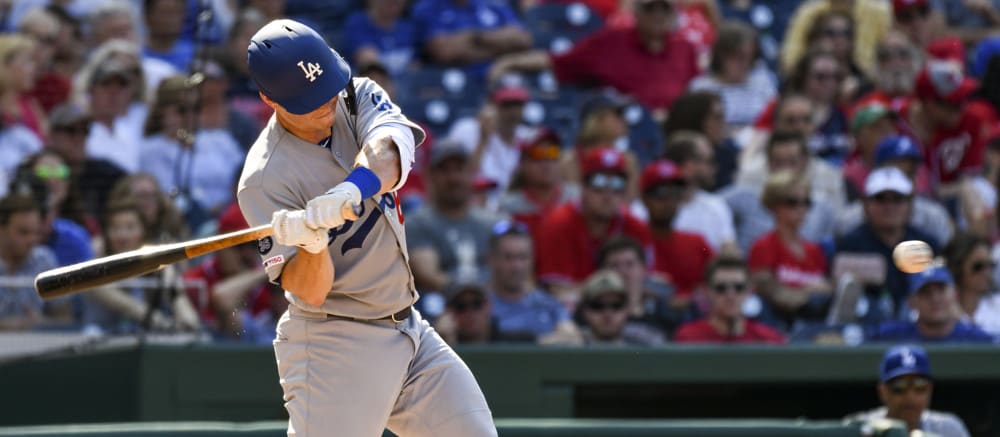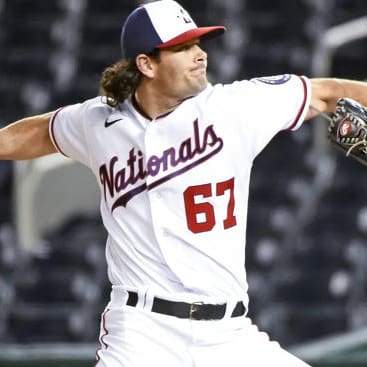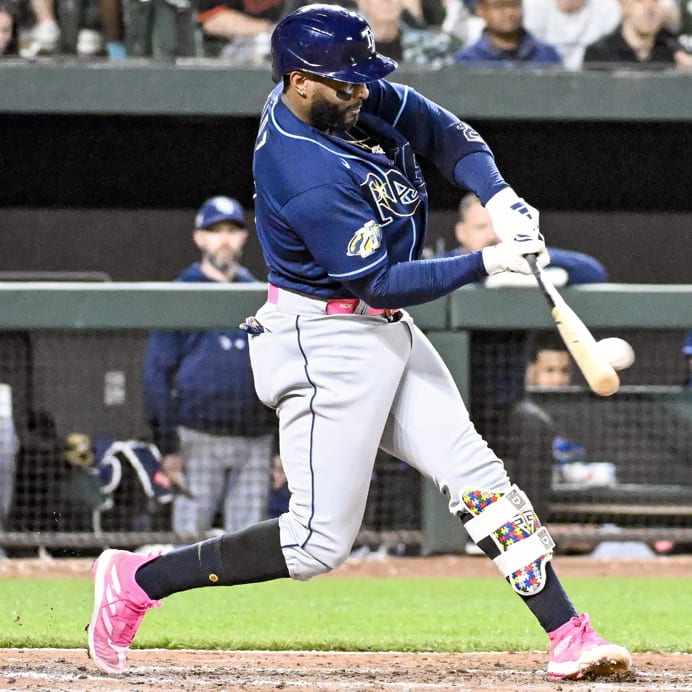This article is part of our Collette Calls series.
Recall the premise of this annual series of bold predictions stated in last week's installment:
It's time, once again, to put myself out there and make 60 predictions for the new season. The premise for this annual article series remains the same: the prediction has to be somewhat grounded in reality but at the same time viewed as unlikely when you first read it. So, you will not find me predicting Ryan Yarbrough to win the Cy Young, but you may see me making calls predicting a breakout for Corbin Burnes as I did in this series just last year. Conversely, you will find some big misses such as me laying out the case why Shane Bieber would not finish the season as a top-20 starting pitcher.
When you play in the margins with predictions, you are going to lose more than you will win. The last three seasons, I've hit on 21 to 24 of the 60 predictions I've made with some rather big hits (Renato Nunez, Blake Snell, Lance Lynn, Jose Abreu) and many more misses. Just last year, this series helped identify the upside of taking a chance on A.J. Pollock, Andrew McCutchen, Asdrubal Cabrera, Ian Happ, Marcell Ozuna, Trent Grisham, Chris Bassitt, the aforementioned Burnes, Tony Gonsolin, and Justus Sheffield.
While I strive for higher rates of accuracy, you will not see me lower the credentials for predictions to increase the chances
Recall the premise of this annual series of bold predictions stated in last week's installment:
It's time, once again, to put myself out there and make 60 predictions for the new season. The premise for this annual article series remains the same: the prediction has to be somewhat grounded in reality but at the same time viewed as unlikely when you first read it. So, you will not find me predicting Ryan Yarbrough to win the Cy Young, but you may see me making calls predicting a breakout for Corbin Burnes as I did in this series just last year. Conversely, you will find some big misses such as me laying out the case why Shane Bieber would not finish the season as a top-20 starting pitcher.
When you play in the margins with predictions, you are going to lose more than you will win. The last three seasons, I've hit on 21 to 24 of the 60 predictions I've made with some rather big hits (Renato Nunez, Blake Snell, Lance Lynn, Jose Abreu) and many more misses. Just last year, this series helped identify the upside of taking a chance on A.J. Pollock, Andrew McCutchen, Asdrubal Cabrera, Ian Happ, Marcell Ozuna, Trent Grisham, Chris Bassitt, the aforementioned Burnes, Tony Gonsolin, and Justus Sheffield.
While I strive for higher rates of accuracy, you will not see me lower the credentials for predictions to increase the chances of the prediction coming true. My goal is not to go 60 for 60 on these; it is to get you thinking differently about each one of these players. Statistical predictions in player capsules or writeups are, at best, within the range of accuracy 70 percent of the time. My purpose is to get you thinking about what could potentially happen in the other 30 percent of the pie.
The small sample of 2020 compounded with all of the related factors in prepping for and playing through a season during a pandemic loom large in the statistics, which is why you'll see a focus on timelines rather than solely focusing on the previous season.
All ADP is from the last 60 days from 89 NFBC drafts
Arizona
Daulton Varsho (ADP 157; high 31 (auto-draft mistake), low 230) finishes outside the top 200. It is easy to see why many are excited about Varsho's potential in 2021. He owns a .301/.372/.507 batting line in more than 1,000 plate appearances in the minor leagues and went 47 of 57 in steals. He is also draft-eligible at catcher this year, which is inflating his value some as well. 2021 should see him more as an emergency catcher with Carson Kelly and Stephen Vogt likely absorbing 99 percent of the time behind the plate.
While I like Varsho's long-term potential, I have concerns for 2021 at his current market price. He has had all of 115 plate appearances above Double-A, and they were not great. He held his own against major league fastballs collecting all three of his homers off them, but he was as lost as a tourist leaving the Orlando airport with non-fastballs, hitting just .137 against those pitches. Triple-A pitchers might not have the velocity of big leaguers, but pitchers in that classification know how to throw breaking balls and changeups, which is why organizations want hitters to spend time there. Most Double-A pitchers are forced to throw a changeup while their breaking balls are still being refined, and that is what I believe Varsho is missing.
Sure, the pedigree and the amateur track record are there, but the lack of experience at the advanced levels of baseball plus the demands of playing a premiere defensive position (center) in 2021 have me concerned this will not be a spike year on his growth curve and that early struggles could lead to a demotion. His ADP continues to rise this season, even when removing the auto-draft, and the risk in rostering him continues to rise. I also can't shake 2007 Robby Hammock flashbacks here, perhaps because it is the same organization.
Caleb Smith (ADP 317; high 255, low 393) finishes outside the top 400. Smith hardly pitched in 2020 because of COVID issues, so just toss out most of what he did last season. The one thing I will give credence to is him adding a curveball to his repertoire, which now gives him, in theory, three pitches to throw to lefties and righties. Last season, he unleashed the new curve once to lefties, though, as he primarily wants to attack them with fastballs and sliders. If you watch him pitch enough, he looks like Robbie Ray with a changeup. The deliveries and velocities are similar, but the next changeup Ray throws will be his first.
Smith has had similar issues to Ray as well. Both can collect strikeouts in bunches, but both do so while inflicting damage to your ERA. At least with Smith, his WHIP does not hurt you as much as Ray's has throughout the years. Smith is the older of the two pitchers despite pitching roughly 600 fewer innings than Ray. Smith, like Ray, has had issues with home runs with a 1.7 HR/9 for his career with his "best" mark at 1.2 in 2018. Smith is an extreme flyball pitcher, so this will always be a risk, and with a normalized NL West schedule, that puts more hitter friendly run environments into play, not to mention facing the two best lineups in baseball more often than other pitchers.
Smith is currently the 122nd pitcher off the board, going in front of the likes of Matthew Boyd, Yusei Kikuchi and even two full rounds in front of his slightly younger twin brother. Admittedly, starting pitching is slim pickings this far down the ADP rankings, but there is upside to be found in other names while the risks with Smith point too many arrows toward negative outcomes for your fantasy roster.
Colorado
Raimel Tapia (ADP 278; high 187, low 351) finishes outside the top-100 outfielders. Tapia is currently OF71, going just behind the likes of Mark Canha, David Peralta and teammate Garrett Hampson. Tapia enjoyed a career offensive season in 2020 in batting average and on-base percentage; by wRC+, he was still below average. One might assume that he gets whatever extra base hits he collects at home, yet he had one more on the road than at home in 2020. The true advantage comes in batting average where he has an even 100-point split between his home average (.337) and road average (.237).
Tapia's 2020 success was fueled by him slapping the ball around the field through holes or utilizing his speed to leg out hits. When you do not hit the ball with much authority, that is how one generates a .392 batting average on balls in play. Tapia used the approach to get results off pitches that exceeded the expected outcomes on those pitches:
| Pitch Grouping | # | AVG | xBA | SLG | xSLG |
|---|---|---|---|---|---|
| Fastballs | 536 | .352 | .268 | .435 | .352 |
| Breaking | 166 | .275 | .211 | .350 | .279 |
| Offspeed | 102 | .278 | .247 | .361 | .319 |
However, Tapia has outperformed his expected metrics, particular on fastballs, throughout his fuller seasons:
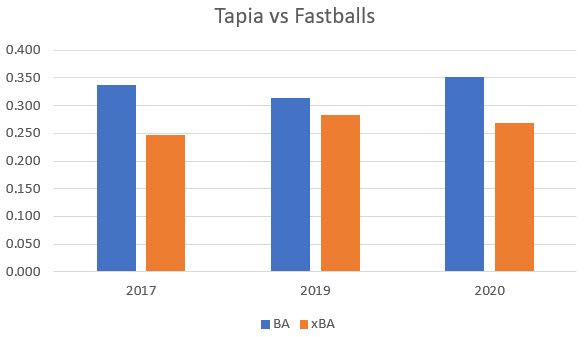
Note the wide gaps in both 2017 (.361 BABIP) and 2020 (.392 BABIP) with a narrower difference in 2019 (.341 BABIP.) Given the league throws Tapia fastballs nearly two-thirds of the time, his performance on the pitch drives his overall success with average and getting on base. He reached base at a .329 clip in 2017 and a .369 clip last season, but just a .309 clip the season prior. If he cannot reach base enough, he will lose that leadoff job and most of his fantasy value in a hurry.
Tapia's value is in his ability to get on base, steal bases and score runs. He lacks power, so any slump in his abilities to lead off take him from the top spot to the bottom spot of the lineup in a hurry. He does not accept many walks because pitchers challenge him in the zone, hoping he hits it to a glove and not into a gap. Hitting in front of Trevor Story, Charlie Blackmon and Nolan Arenado is an envious position that could allow Tapia to score 100 runs if he can repeat what he showed in 2020. If he lapses back to 2019, he could lose his starting job and the volume of playing time needed to take advantage of his best asset — his speed.
Robert Stephenson (ADP 721; high 568, low 750) is a top 250 pitcher. Stephenson is currently the 324th pitcher off the board after his recent relocation from Cincinnati to Denver. Stephenson was one of the better relievers in baseball in 2019 with a 22 percent K-BB%, while holding hitters to a .181 average as he turned his slider into his primary pitch. He held hitters to a .125 average off his slider with a 52 percent strikeout rate ... and then 2020 happened.
Stephenson dealt with a back strain and tried to pitch through it, but simply could not. He faced 43 batters, allowing 11 hits, eight home runs and 11 earned runs in 10 innings. Reliever volatility is a real thing, and we have seen many pitchers go from boom to bust in a hurry, but Stephenson's issues can at least be attributed to a back problem that did not allow him to properly finish his pitches and messed with his mechanics. The slider was still deadly (.167 BAA, 48.0 K%), but his non-sliders got crushed.
Stephenson enters a bullpen where Daniel Bard has a firm grip on the closer role, but there are many questions in the rest of the bullpen. If he is healthy and rediscovers the abilities that created this 2019 StatCast slider profile, he could find himself in high-leverage work to get the ball to Bard or even take over the role himself should something happen to Bard:
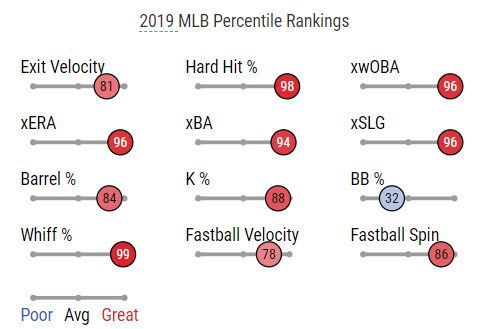
Los Angeles
Will Smith (ADP 103; high 61, low 130) finishes as the top fantasy catcher. Sure, on paper, Smith going from C3 to C1 is not a big deal. However, understand that he is currently going 67 spots after J.T. Realmuto, so this is a bold prediction. Realmuto is likely not returning to the Phillies, which puts him under the danger of Glenn Colton and Rick Wolf's S.M.A.R.T. system that warns us about free agents in the first year of deals in new homes. Should Realmuto return to Philly, this prediction becomes tougher to achieve. The other hurdle that Smith has to jump is Salvador Perez and his near-100 percent playing time at catcher as he had a tremendous rebound season in 2020.
Smith had a big year at the plate with his xSLG, xwOBA and wOBA finishing in the top 90th percentile of the league. He was already a patient hitter at the plate, but took that to another level as he improved his walk rate by five percentage points while reducing his strikeout rate 10 percentage points last season. To find a weakness in his approach at the plate, you have to focus on breaking balls as he has barely hit .200 against them in his major league career, though he improved his ability to handled them year over year and reduced his K% on those pitches from 36 to 21 percent last season. 2020 was already a breakout of sorts, but I believe there is another level for him. He is going to hit in the heart of a loaded lineup with protection in front as well as behind.
We have not had a full-time catcher drive in more than 90 runs since Buster Posey in 2015. Smith is in a prime position to become the next guy to do that, so let your opposition spend a third or fourth-round pick on Realmuto or a fifth/sixth on Perez. Once those catchers are off the board, do not wait too long to grab Smith, as you already have a bargain at his current price.
David Price (ADP 175, 108, low 272) finishes as a top-40 fantasy pitcher. Price is currently the 65th pitcher off the board, going just after the likes of Tyler Mahle and German Marquez and just before Aaron Civale and Triston McKenzie. Price sat out 2020 due to COVID. He had had his fill with pitching in Boston and wanted out, and got his out via trade before last season. Price never looked like the Cy Young winner model from 2012 or the guy who pitched for his massive contract in 2014 and 2015 in Boston, but still found a good amount of success around injuries.
When last we saw Price pitch, he set a career high in strikeout rate while maintaining his ability to control walks, yet had issues with the long ball with Fenway as his home park and Camden, Yankee Stadium and Rogers Centre as frequent road stops. 2019 saw Price throw his four-seamer, changeup and sinker in near equal percentages with the cutter and curveball bringing up the rear. His fastball velocity is not what it once was, but perhaps the year away from the sport will give his arm and mechanics a needed break to recover his stuff. He pitches with such command that the big fastball is no longer necessary, but he still needs it to set up his other stuff.
He obviously will not be hurting for run support in Los Angeles, and the home park should be more cozy for him than Fenway ever was. Price has traditionally pitched deep into games, positioning himself for more decisions, and the Dodger bullpen is once again well-positioned to protect its inherited leads. The year away from the sport seems to have discounted Price while drafters are underestimating just how miserable he was in Boston in 2019.
San Diego
Jake Cronenworth (ADP 152; high 121, low 212) does not finish as a top-200 player. His entire StatCast page is full of red ink, which makes this one of the bolder predictions and deserves more explanation than "Jason is just bitter the Rays gave this guy up in a trade:"
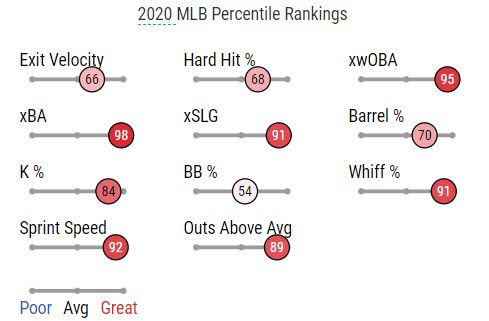
We knew Cronenworth could hit as he raked to the tune of a .334/.429/.520 clip in Triple-A Durham in 2019 in 406 plate appearances with 10 homers and 12 steals. Yet, he was sent packing along with Tommy Pham for the since-released Hunter Renfroe along with Xavier Edwards.
Cronenworth's trade was the second consecutive season the club dealt a bat who went onto perform well in his new home (Nick Solak the other.) At least with Solak, the concerns about his defense were well known, but Cronenworth's versatility and plate skills would have made a nice fit but the Rays appeared married to Joey Wendle in that role.
Cronenworth spent his rookie season accepting his walks, making a lot of contact and barreling up the baseball, especially in the first half of the season. His production fell in the second half of the season as the league started to figure out how to attack him, and he struggled to adjust to what they were doing:
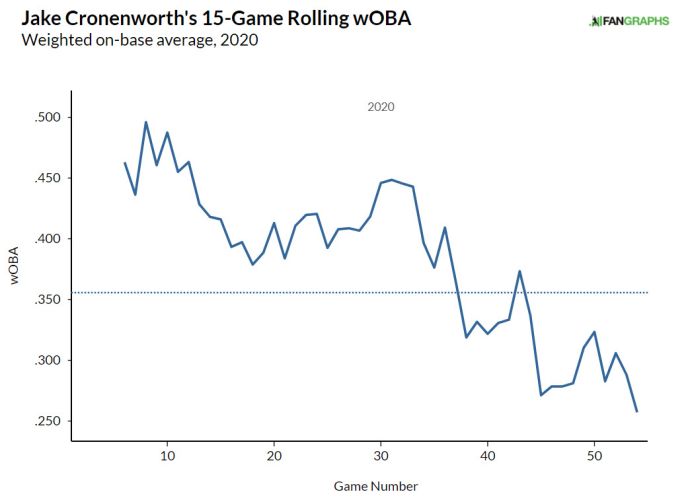
The rookie also had his issues against lefties, hitting .218 with two extra base hits, but had no such troubles in 2019 in Triple-A (.348) and landed somewhat in between in 2018 between Double-A and Triple-A (.256.) The mashing in Durham is obviously an outlier, but Cronenworth is by no means a must-platoon bat yet.
Why I believe Cronenworth will struggle to meet expectations is that the lineup card in San Diego is quite crowded since the club signed Ha-seong Kim this winter. The Padres did not sign Kim to ride the pine for long, and given the rest of the lineup is rather entrenched, I believe Cronenworth's playing time will get dinged. He has the versatility to move around the diamond to offer days off or to cover left field for the next Tommy Pham injury, but I struggle to see a path to everyday playing time for the 27-year-old sophomore.
Drew Pomeranz (ADP 265; high 171, low 424) finishes as a top 125 player. If you statistically scout Pomeranz, you'll be quick to move onto the next name on the list because his numbers have truly been all over the place. He won 17 games with a 3.32 ERA in 2017, had a 6.08 ERA the following season, then followed that with a 2-10 record and a 4.85 ERA in 2019 before flashing some brilliance in 2020. The last six seasons he has been a full-time starter, a swing man and, most recently, a closer for the Padres once Kirby Yates was injured and Emilio Pagan could not pick up the slack.
Pomeranz's transition to full-time relief works because he does not have to conserve his velocity. Note his uptick in fastball velocity once he was converted to full-time relief by Milwaukee after he was acquired from San Francisco's rotation, which led to a career-high swing-and-miss rate on his fastball as well:
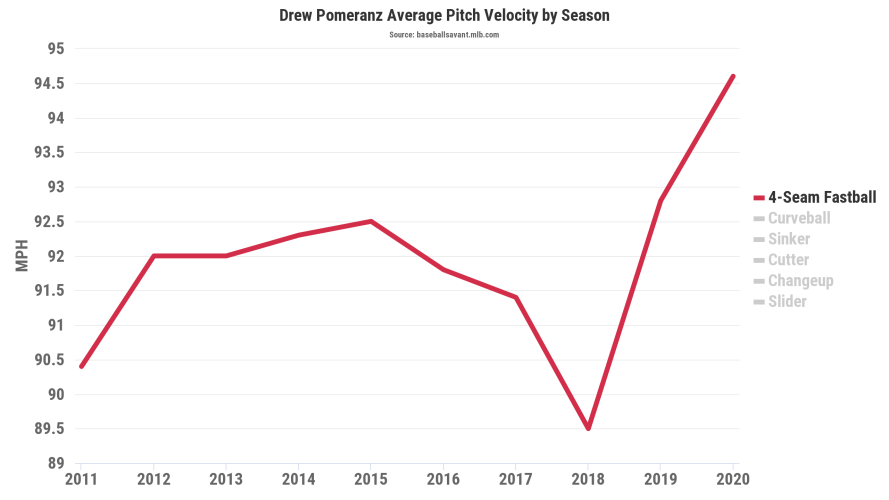
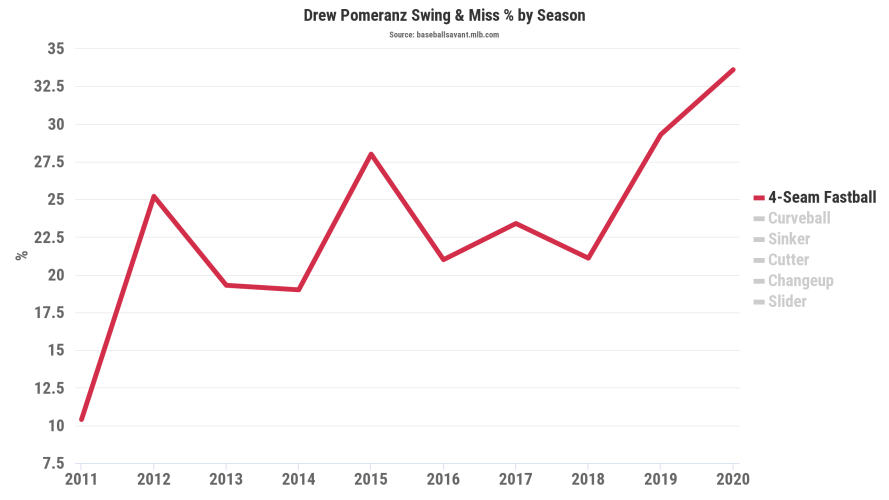
Pomeranz has thrown his last 45 innings as a full-time reliever and has allowed 25 hits while striking out 74 batters with five home runs and a 2.00 ERA and 0.96 WHIP.
Pomeranz is currently the 99th pitcher off the board in drafts with the following relievers in front of him and behind him:
- Matt Barnes: ADP 227
- Jordan Romano: ADP 236
- Will Smith: ADP 258
- Pomeranz: ADP 265
- Kwang Hyun Kim: ADP 270
- Jordan Hicks: ADP 272
- Giovanny Gallegos: ADP 294
The market currently considers Pomeranz only slightly better than the three-headed question mark in St. Louis? Simply put, Pomeranz is being highly undervalued and has the potential to have a big season with saves and strikeouts, given he can do more than the one-inning outing. Every year I look for a guy to save 40 games and strike out 100 batters; Pomeranz has the potential to be that guy this year with this abilities and a loaded San Diego roster that could push for 100-plus wins.
San Francisco
Jason Vosler (ADP 740; high 578, low 743) finishes as a top-500 player. Just last season, San Diego benefitted from the production of the aforementioned Cronenworth because Tampa Bay did not believe it had room in its lineup for him. San Francisco could very well benefit from similar treatment after San Diego allowed Vosler to leave as a minor-league free agent because it absolutely had a logjam at his positions (first and third) that was not going to be resolved soon. San Francisco has a good track record of taking other organization's backlog (Mike Yastrzemski, Donovan Solano, Alex Dickerson) or castoffs (Kevin Gausman, Drew Smyly — more on that later) and getting something out of them. This is why I like Vosler's chance to become a productive part of the roster this year.
Vosler only spent a season with San Diego after arriving in a trade from Chicago, and made the most of his time in El Paso with 20 homers and a .291/.367/.523 batting line. That was the second time he hit as many as 20 homers in a minor-league season around a career of solid plate discipline. His defense is going to limit him to a corner infield position or DH, but scouts threw a 60 raw power score on his report as recently as last season with 50 in-game power on the 20-80 scale.
The only player in the projected lineup for San Francisco younger than 30 is Mauricio Dubon, and Longoria is now older than 35 and has missed chunks of time in two of the last three seasons. If the DH is back in play for the NL in 2021, Vosler has a good chance of grabbing even more playing time with his offensive upside. If the DH is not in play, then his value hinges upon the health of the other players in front of him.
Anthony DeSclafani (ADP 503; high 284, low 649) finishes as a top-150 pitcher. The 150th pitcher by ADP is currently Miles Mikolas at pick 403, so DeSclafani has to make quite a leap to make this projection come true. As I mentioned with Vosler, San Francisco has done an excellent job of making something from nothing with players, including pitchers. The expectations for Gausman and Smyly were low when they went to San Francisco, yet both have revived their careers and Smyly even landed an $11M contract 15 months after being released by Texas.
One thing that San Francisco likes to do is to tell pitchers to emphasize their best pitch, so it will be interesting to see where they go with Disco. He was primarily a two-fastball and slider guy with Cincinnati as those pitches represent roughly 80 percent of what he has thrown in recent seasons. He has five pitches in all, and uses all against lefties but shelves the changeup against righties. The Giants altered Gausman by encouraging him to leverage his splitter more than ever while they adjusted Smyly by simplifying his repertoire to eliminate his changeup and asking him to throw his curve as his offspeed pitch.
The tweak I could see coming is the club has him drop the curveball and go with the slider as his primary breaking ball. His slider and curve have had an interesting journey pre- and post-elbow injury in 2017. Note how further apart the break was on the pitches pre-injury compared to now:
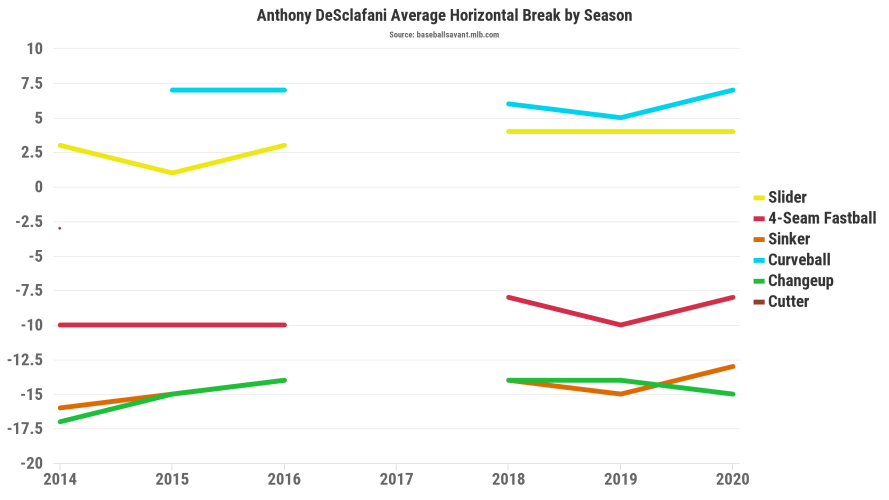
It may be that their closeness is doing the pitch a disservice because the curveball's effectiveness as the swing-and-miss on that pitch last year fell off a cliff:
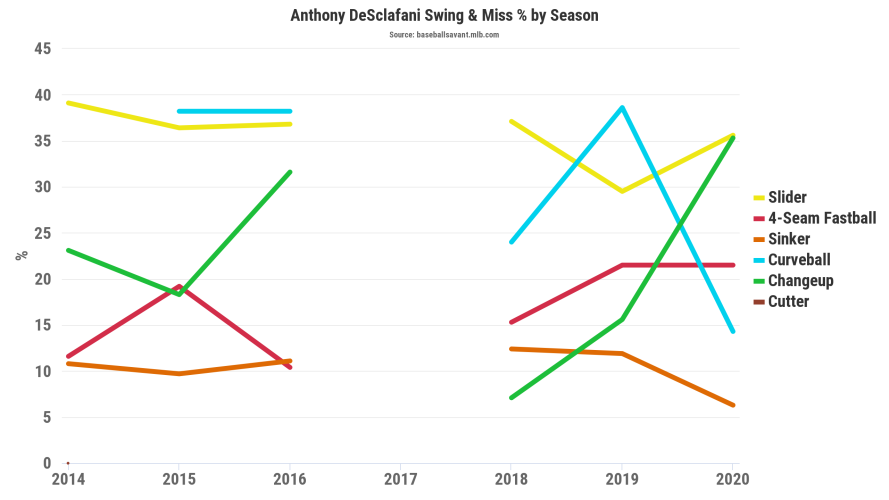
The Giants have certainly earned a reputation for getting more from pitchers than thought possible, and DeSclafani has had bouts of success in recent seasons around issues with home runs. There are worse end-game darts to throw to see if the Giants have found a new market inefficiency.

